How Many Day 3 Embryos Make It To Blastocyst
Blastocyst Development
From Embryology
Jump to:navigation, search
| Embryology - 3 Jan 2023 |
|---|
| Google Translate - select your linguistic communication from the listing shown beneath (this will open a new external page) |
| العربية | català | 中文 | 中國傳統的 | français | Deutsche | עִברִית | हिंदी | bahasa Indonesia | italiano | 日本語 | 한국어 | မြန်မာ | Pilipino | Polskie | português | ਪੰਜਾਬੀ ਦੇ | Română | русский | Español | Swahili | Svensk | ไทย | Türkçe | اردو | ייִדיש | Tiếng Việt These external translations are automatic and may not exist accurate. (More? About Translations) |
Introduction
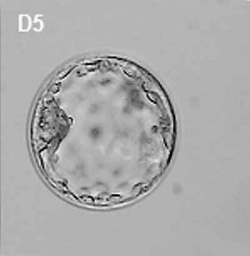
Human being Blastocyst (mean solar day five)[one]
(Greek, blastos = sprout + cystos = cavity) or blastula, the term used to describe the hollow cellular mass that forms in early development.
The blastocyst consists of cells forming an outer trophectoderm (TE, trophoblast) layer, an inner cell mass (ICM, embryo boom) and a blastocoel (fluid-filled cavity). The inner prison cell mass will form the entire embryo, and is the source of true embryonic stalk cells capable of forming all cell types within the embryo. In mammals, the trophectoderm volition form key cells (trophoblast) of the fatal component of the placenta.
In humans, blastocyst stage of development occurs during the first and 2d calendar week following fertilization (GA week iii and iv) and is described initially as Carnegie stage 3. This stage is followed by blastocyst hatching and implantation.
1 of the first key developmental patterning decisions in the morula to blastocyst development is TE or ICM cell fate. In the mouse model, Hippo[2](TEAD4) and Notch[3](Cdx2) together appear regulate this early on fate decision.
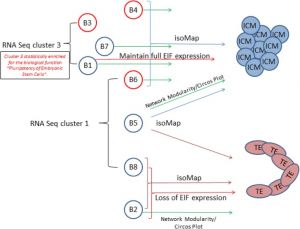
Blastomere genomic divergence[4]
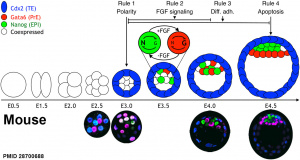
Mouse blastocyst evolution[five]
Some Recent Findings
- Human blastoids model blastocyst development and implantation [half-dozen] "One week after fertilization, human embryos implant into the uterus. This result requires that the embryo forms a blastocyst consisting of a sphere encircling a cavity lodging the embryo proper. Stem cells can form a blastocyst model, which we termed blastoid1. Here we show that naive human pluripotent stem cells (PXGL hPSCs)two triply inhibited for the Hippo, TGF-β, and ERK pathways efficiently (>70%) class blastoids generating blastocyst-stage analogs of the 3 founding lineages (>97% trophectoderm, epiblast, and primitive endoderm) according to the sequence and timing of blastocyst evolution. Blastoids spontaneously grade the first axis and nosotros detect that the epiblast induces the maturation of the polar trophectoderm that consequently acquires the specific capacity to attach to hormonally-stimulated endometrial cells, equally during implantation. Such a human blastoid is a faithful, scalable, and ethical model to explore human implantation and evolution."
- Computational analysis of single-cell transcriptomics data elucidates the stabilization of Oct4 expression in the E3.25 mouse preimplantation embryo [7] "Our computational analysis focuses on the 32- to 64-cell mouse embryo transition, Embryonic twenty-four hours (three.25), whose study in literature is concentrated mainly on the search for an early on onset of the second cell-fate decision, the specification of the inner cell mass (ICM) to primitive endoderm (PE) and epiblast (EPI). We analysed single-cell (sc) microarray transcriptomics data from E3.25 using Hierarchical Optimal k-Means (HOkM) clustering, and identified two groups of ICM cells: a group of cells from embryos with less than 34 cells (E3.25-LNCs), and another group of cells from embryos with more than 33 cells (E3.25-HNCs), corresponding to two developmental stages. Although we found massive underlying heterogeneity in the ICM cells at E3.25-HNC with over iii,800 genes with transcriptomics bifurcation, many of which are PE and EPI markers, we showed that the E3.25-HNCs are neither PE nor EPI. Importantly, analysing the differently expressed genes between the E3.25-LNCs and E3.25-HNCs, we uncovered a non-autonomous mechanism, based on a minimal number of four inner-cell contacts in the ICM, which activates Oct4 in the preimplantation embryo. Oct4 is highly expressed but unstable at E3.25-LNC, and stabilizes at high level at E3.25-HNC, with Bsg highly expressed, and the chromatin remodelling program initialised to plant an early naïve pluripotent land. Our results indicate that the pluripotent state we found to be in the ICM at E3.25-HNC is the in vivo counterpart of a new, very early on pluripotent land. We compared the transcriptomics profile of this in vivo E3.25-HNC pluripotent country, together with the profiles of E3.25-LNC, E3.five EPI and E4.5 EPI cells, with the profiles of all embryonic stalk cells (ESCs) bachelor in the GEO database from the same platform (over 600 microarrays)."
- Physiological profile of undifferentiated bovine blastocyst-derived trophoblasts [8] "Trophectoderm of blastocysts mediate early on events in fetal-maternal communication, enabling implantation and establishment of a functional placenta. Inadequate or impaired developmental events linked to trophoblasts directly affect early on embryo survival and successful implantation during a crucial menstruum that corresponds with high incidence of pregnancy losses in dairy cows. As yet, the molecular basis of bovine trophectoderm development and signaling towards initiation of implantation remains poorly understood. In this study, we developed methods for culturing undifferentiated bovine blastocyst-derived trophoblasts and used both transcriptomics and proteomics in early colonies to categorize and elucidate their functional characteristics. A full of 9270 transcripts and 1418 proteins were identified and analyzed based on absolute abundance. We profiled an extensive list of growth factors, cytokines and other relevant factors that tin effectively influence paracrine communication in the uterine microenvironment. Functional categorization and analysis revealed novel information on structural organization, extracellular matrix limerick, cell junction and adhesion components, transcription networks, and metabolic preferences. Our information showcase the key physiology of bovine trophectoderm and indicate hallmarks of the self-renewing undifferentiated land akin to trophoblast stem cells described in other species."
| More than recent papers |
|---|
| This tabular array allows an automatic computer search of the external PubMed database using the listed "Search term" text link.
More? References | Discussion Folio | Periodical Searches | 2019 References | 2020 References Search term: Blastocyst Development | Blastocyst | Blastocoel | Inner Cell Mass | | Trophectoderm |
| Older papers |
|---|
| These papers originally appeared in the Some Recent Findings table, but as that list grew in length accept now been shuffled down to this collapsible table. See besides the Discussion Folio for other references listed past yr and References on this electric current folio.
|
Movies
Human Blastocyst
|
|
|
Model Development
Movies
A recent review{{#pmid28681376|PMID28681376}} of the initial morula to blastocyst formation, based upon animal models, identifies important mechanical steps:
- Compaction - morula blastomeres packing tightly (microfilament cytoskeleton)
- Cleavage planes - spindle direction of dividing cells (mitosis).
- Polarisation - blastomeres apico-basal (Hippo pathway, Yep-associated protein (Yap)
- Cavitation - blastocoel formation with cycles of crenel expansion and collapse.
- epiblast cells - contact the polar trophectoderm
- primitive endoderm - facing the cavity
Human Blastocyst Germination
The table beneath shows human blastocyst in vitro development changes during week i.[14]

Labeled Blastocyst
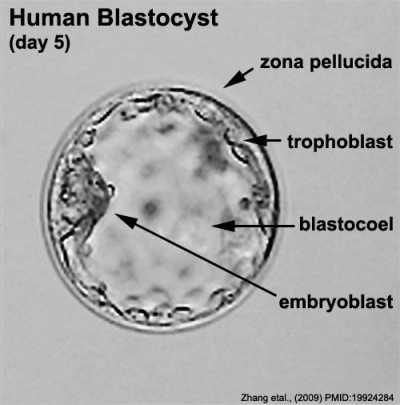
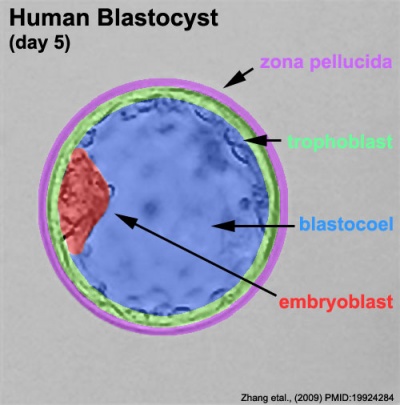
Blastocyst Hatching
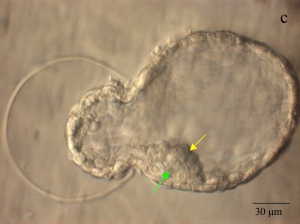
Mouse Blastocyst hatching[15]
Model Human being Blastocyst Evolution
The following figure is from a recent study[eleven] using video and genetic analysis of in vitro human development during week i post-obit fertilization.

- EGA - embryonic genome activation
- ESSP - embryonic stage–specific pattern, iv unique embryonic phase–specific patterns (1-4)
- Links: Effigy with legend
Mouse Blastocyst Gene Expression

General gene expression patterns are indicated from genomic profiling.[xvi]
- cerise - loss of maternal mRNAs
- green - activation of embryonic genome (EGA)
- purple - maternal gene activation (MGA)
- orange - continuous expression
Inner Cell Mass
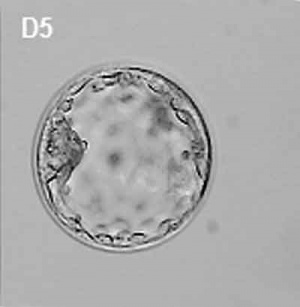
Human Blastocyst (day 5)[one]
The inner cell mass forms an inner layer of larger cells is as well chosen the "embryoblast" is a cluster of cells located and attached on 1 wall of the outer trophoblast layer. In week 2 this mass volition differentiate into two distinct layers the epiblast and hypoblast.
The hypoblast (or primitive endoderm) is a transient epithelial layer facing towards the blastoceol, it is replaced in calendar week three past the gastrulation migrating endoderm cells.
The epiblast layer will grade the entire embryo and undergoes gastrulation in week three to form the 3 germ layers. It too forms an epithelial layer lining the amniotic cavity.
Trophectoderm
The trophectoderm (TE) outer layer of smaller cells is besides called the "trophoblast" epithelium, that volition after form a fundamental component of the placenta. A primal early on function is for the transport of sodium (Na+) and chloride (Cl-) ions through this layer into the blastocoel. Later in week ii this layer will differentiate into two distinct trophoblast layers the syncytiotrophoblast and cytotrophoblast cells and are key to implantation and early placentation.
Differentiation of the early layer has been shown to exist regulated by the transcription factors Tead4[17] and then Caudal-related homeobox ii (Cdx2).
- Links: trophoblast | OMIM -Tead4 | OMIM - Cdx2
Blastocoel
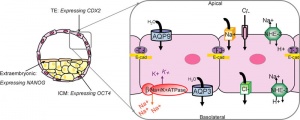
Mouse - blastocoel formation[16]
- trophectoderm transports of Na+ and Cl- ions through this layer into the blastocoel
- generates an osmotic gradient driving fluid across this epithelium
- distinct upmost and basolateral membrane domains specific for ship
- facilitates transepithelial Na+ and fluid send for blastocoel formation
- ship is driven by Na, K-adenosine triphosphatase (ATPase) in basolateral membranes of the trophectoderm [18]
Blastocyst Metabolism
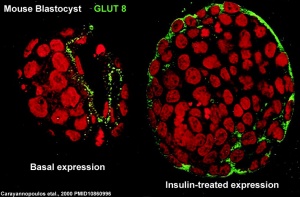
Mouse blastocyst GLUT8 expression.[19]
At the blastocyst stage, mammalian development metabolism switches on anaerobic glycolysis metabolism to satisfy metabolic demands of growing blastocyst and formation of the blastocoel. This is idea to be driven by the integral membrane protein family of facilitative glucose transporters (Overabundance or SLC2A).
- aerobic - oxidation of lactate and pyruvate via the citric acrid cycle (Krebs cycle) and oxidative phosphorylation
- glycolysis- converts glucose into pyruvate
- Overabundance - GLUcose Transporter (divided into 3 classes I-III)
- SLC2 - Solute Carrier Family 2
Glucose Transporter Expression
- GLUT1 - from zygote to blastocyst. (all mammalian tissues, basal glucose uptake)
- GLUT2 and GLUT3 - from late eight cell phase to blastocyst. (GLUT2, liver and pancreatic beta cells; GLUT3, all mammalian tissues, basal glucose uptake)
- GLUT4 - not expressed. (musculus and adipose tissue)
- GLUT8 - upwards-regulated at blastocyst stage. (central nervous system and eye)
- (Data mainly from mouse development, adult tissue expression shown in brackets)
A mouse written report,[19] has shown GLUT8 is up-regulated following insulin stimulation, though a more recent GLUT8 knockout mouse shows normal early embryonic evolution in the absence of this transporter.[20]
- Links: Biochemistry - glucose transporters | GLUT1 | GLUT2 | GLUT8
Blastula Cell Communication
Two types of cell junctions have been identified located at different regions in the developing blastocyst.
| Tight junctions Located close to outer surface create a seal, isolates interior of embryo from external medium. | Gap junctions Allow electrically coupling of the cells of epithelium surrounding the fluid-filled cavity. |
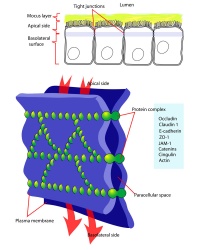 |  |
- Adhesion EM Images: GIT epithelia EM1 | GIT epithelia EM2 | GIT epithelia EM3 | Desmosome EM
- Adhesion Cartoons: Tight junction | Adherens Junction | Desmosome | Gap Junction
Blastocyst Hatching - zona pellucida lost, ZP has sperm entry site, and entire ZP broken downwards past uterine secretions and mayhap blastula secretions.
Uterine Glands - secretions required for blastocyst motility and nutrition
- Links: MBoC Figure 21-69. The blastula
Blastocyst Hatching
| At about day 5 the human blastocyst "hatches" out of the protective zona pellucida. This hatching allows increased growth, access to uterine food secretions and blastocyst adhesion to the uterine lining. Associated with this hatching process are a series of concrete contractions.
| <mediaplayer width='500' height='450' prototype="http://php.med.unsw.edu.au/embryology/images/a/af/Human_blastocyst_day_5-half dozen.jpg">File:Human_blastocyst_day_5-6.mp4</mediaplayer> Human blastocyst contractions (24-hour interval 5-six)[11] |
Molecular Factors
- TEA Deoxyribonucleic acid- binding domain, these factors bind to the consensus TEA/ATTS cognate binding site[23]
- TEF-3 - renamed Tead1 and Tead4
- Tead3 - is expressed in the placental syncytiotrophoblasts
- Eastward-cadherin - Calcium ion-dependent cell adhesion molecule, a jail cell membrane adhesive protein required for morula compaction
- epithin - A type II transmembrane serine protease, identified in mouse for compaction of the morula during preimplantation embryonic development. Expressed from 8-jail cell stage at blastomere contacts and co-localises in the morula with E-cadherin.[24]
- Na, Grand-adenosine triphosphatase - A sodium potassium pump that generates an osmotic gradient for fluid menstruation into the blastocoel
- Zonula occludens-ane - (ZO-1) Tight junction protein involved in morula to blastocyst transformation in the mouse [25]
Blastocyst in Other Species
Mouse Blastocyst
-

Sox2 expression[26]
-
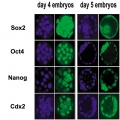
Early on factor expression[26]
-

Early gene expression[26]
-
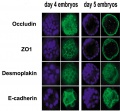
Early on gene expression[26]
-

Early cistron expression[26]
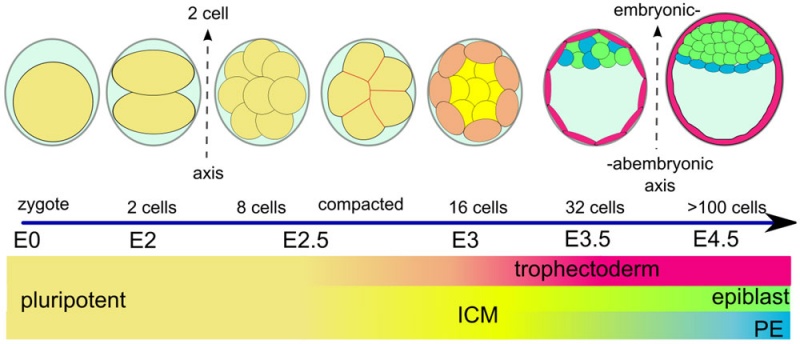
Early on mouse evolution model[27]
- Links: Mouse Development
Bovine Blastocyst
-

Bovine blastocyst KRT18, FN1 and MYL6 expression
-

Bovine blastocyst KRT18 and MYL6 expression
- Links: Bovine Evolution
References
- ↑ 1.0 i.i Zhang P, Zucchelli M, Bruce S, Hambiliki F, Stavreus-Evers A, Levkov L, Skottman H, Kerkelä Eastward, Kere J & Hovatta O. (2009). Transcriptome profiling of human pre-implantation evolution. PLoS Ane , four, e7844. PMID: 19924284 DOI.
- ↑ Sasaki H. (2015). Position- and polarity-dependent Hippo signaling regulates jail cell fates in preimplantation mouse embryos. Semin. Cell Dev. Biol. , 47-48, 80-7. PMID: 25986053 DOI.
- ↑ Rayon T, Menchero S, Nieto A, Xenopoulos P, Crespo Thou, Cockburn Yard, Cañon Southward, Sasaki H, Hadjantonakis AK, de la Pompa JL, Rossant J & Manzanares Yard. (2014). Notch and hippo converge on Cdx2 to specify the trophectoderm lineage in the mouse blastocyst. Dev. Prison cell , 30, 410-22. PMID: 25127056 DOI.
- ↑ Smith HL, Stevens A, Minogue B, Sneddon S, Shaw L, Forest 50, Adeniyi T, Xiao H, Lio P, Kimber SJ & Brison DR. (2019). Systems based analysis of homo embryos and cistron networks involved in cell lineage allocation. BMC Genomics , twenty, 171. PMID: 30836937 DOI.
- ↑ v.0 5.1 Nissen SB, Perera Yard, Gonzalez JM, Morgani SM, Jensen MH, Sneppen Thou, Brickman JM & Trusina A. (2017). Four simple rules that are sufficient to generate the mammalian blastocyst. PLoS Biol. , xv, e2000737. PMID: 28700688 DOI.
- ↑ Kagawa H, Javali A, Khoei HH, Sommer TM, Sestini One thousand, Novatchkova Thou, Scholte Op Reimer Y, Castel 1000, Bruneau A, Maenhoudt N, Lammers J, Loubersac S, Freour T, Vankelecom H, David L & Rivron N. (2021). Human blastoids model blastocyst development and implantation. Nature , , . PMID: 34856602 DOI.
- ↑ Gerovska D & Araúzo-Bravo MJ. (2019). Computational analysis of single-cell transcriptomics data elucidates the stabilization of Oct4 expression in the E3.25 mouse preimplantation embryo. Sci Rep , nine, 8930. PMID: 31222057 DOI.
- ↑ Pillai VV, Siqueira LG, Das M, Kei TG, Tu LN, Herren AW, Phinney BS, Cheong SH, Hansen PJ & Selvaraj 5. (2019). Physiological profile of undifferentiated bovine blastocyst-derived trophoblasts. Biol Open , viii, . PMID: 30952696 DOI.
- ↑ Maître JL, Turlier H, Illukkumbura R, Eismann B, Niwayama R, Nédélec F & Hiiragi T. (2016). Asymmetric division of contractile domains couples jail cell positioning and fate specification. Nature , 536, 344-348. PMID: 27487217 DOI.
- ↑ Le Bin GC, Muñoz-Descalzo South, Kurowski A, Leitch H, Lou X, Mansfield West, Etienne-Dumeau C, Grabole Due north, Mulas C, Niwa H, Hadjantonakis AK & Nichols J. (2014). Oct4 is required for lineage priming in the developing inner jail cell mass of the mouse blastocyst. Development , 141, 1001-10. PMID: 24504341 DOI.
- ↑ 11.0 11.1 11.2 Wong CC, Loewke KE, Bossert NL, Behr B, De Jonge CJ, Baer TM & Reijo Pera RA. (2010). Non-invasive imaging of homo embryos before embryonic genome activation predicts development to the blastocyst phase. Nat. Biotechnol. , 28, 1115-21. PMID: 20890283 DOI.
- ↑ Parks JC, McCallie BR, Janesch AM, Schoolcraft WB & Katz-Jaffe MG. (2011). Blastocyst factor expression correlates with implantation potential. Fertil. Steril. , 95, 1367-72. PMID: 20864103 DOI.
- ↑ Yamanaka Y, Lanner F & Rossant J. (2010). FGF signal-dependent segregation of primitive endoderm and epiblast in the mouse blastocyst. Development , 137, 715-24. PMID: 20147376 DOI.
- ↑ Fong CY & Bongso A. (1999). Comparing of human blastulation rates and full cell number in sequential culture media with and without co-culture. Hum. Reprod. , 14, 774-81. PMID: 10221713
- ↑ Tanaka N, Takeuchi T, Neri QV, Sills ES & Palermo GD. (2006). Laser-assisted blastocyst dissection and subsequent tillage of embryonic stem cells in a serum/jail cell free culture organisation: applications and preliminary results in a murine model. J Transl Med , iv, 20. PMID: 16681851 DOI.
- ↑ 16.0 16.1 Bell CE, Calder MD & Watson AJ. (2008). Genomic RNA profiling and the programme decision-making preimplantation mammalian evolution. Mol. Hum. Reprod. , 14, 691-701. PMID: 19043080 DOI.
- ↑ Nishioka N, Yamamoto South, Kiyonari H, Sato H, Sawada A, Ota M, Nakao 1000 & Sasaki H. (2008). Tead4 is required for specification of trophectoderm in pre-implantation mouse embryos. Mech. Dev. , 125, 270-83. PMID: 18083014 DOI.
- ↑ Kidder GM & Watson AJ. (2005). Roles of Na,Thou-ATPase in early development and trophectoderm differentiation. Semin. Nephrol. , 25, 352-v. PMID: 16139691 DOI.
- ↑ 19.0 xix.1 Carayannopoulos MO, Chi MM, Cui Y, Pingsterhaus JM, McKnight RA, Mueckler Thou, Devaskar SU & Moley KH. (2000). GLUT8 is a glucose transporter responsible for insulin-stimulated glucose uptake in the blastocyst. Proc. Natl. Acad. Sci. U.South.A. , 97, 7313-8. PMID: 10860996
- ↑ Membrez Grand, Hummler E, Beermann F, Haefliger JA, Savioz R, Pedrazzini T & Thorens B. (2006). GLUT8 is disposable for embryonic development only influences hippocampal neurogenesis and heart role. Mol. Cell. Biol. , 26, 4268-76. PMID: 16705176 DOI.
- ↑ <pubmed>14967891</pubmed>
- ↑ Yamazaki K & Kato Y. (1989). Sites of zona pellucida shedding by mouse embryo other than muran trophectoderm. J. Exp. Zool. , 249, 347-ix. PMID: 2708952 DOI.
- ↑ Jacquemin P, Hwang JJ, Martial JA, Dollé P & Davidson I. (1996). A novel family of developmentally regulated mammalian transcription factors containing the TEA/ATTS Dna binding domain. J. Biol. Chem. , 271, 21775-85. PMID: 8702974
- ↑ Khang I, Sonn S, Park JH, Rhee K, Park D & Kim K. (2005). Expression of epithin in mouse preimplantation development: its functional office in compaction. Dev. Biol. , 281, 134-44. PMID: 15848395 DOI.
- ↑ Wang H, Ding T, Brown N, Yamamoto Y, Prince LS, Reese J & Paria BC. (2008). Zonula occludens-1 (ZO-1) is involved in morula to blastocyst transformation in the mouse. Dev. Biol. , 318, 112-25. PMID: 18423437 DOI.
- ↑ 26.0 26.one 26.2 26.3 26.4 Keramari M, Razavi J, Ingman KA, Patsch C, Edenhofer F, Ward CM & Kimber SJ. (2010). Sox2 is essential for formation of trophectoderm in the preimplantation embryo. PLoS ONE , v, e13952. PMID: 21103067 DOI.
- ↑ Krupinski P, Chickarmane V & Peterson C. (2011). Simulating the mammalian blastocyst--molecular and mechanical interactions blueprint the embryo. PLoS Comput. Biol. , 7, e1001128. PMID: 21573197 DOI.
Reviews
Maître JL. (2017). Mechanics of blastocyst morphogenesis. Biol. Jail cell , 109, 323-338. PMID: 28681376 DOI.
Rasmussen TP & Corry GN. (2010). Epigenetic pre-patterning and dynamics during initial stages of mammalian preimplantation evolution. J. Cell. Physiol. , 225, 333-half dozen. PMID: 20607796 DOI.
Cockburn K & Rossant J. (2010). Making the blastocyst: lessons from the mouse. J. Clin. Invest. , 120, 995-1003. PMID: 20364097 DOI.
Rossant J. (2007). Stem cells and lineage development in the mammalian blastocyst. Reprod. Fertil. Dev. , 19, 111-8. PMID: 17389140
Articles
Smith HL, Stevens A, Minogue B, Sneddon South, Shaw L, Wood L, Adeniyi T, Xiao H, Lio P, Kimber SJ & Brison DR. (2019). Systems based analysis of homo embryos and gene networks involved in prison cell lineage allocation. BMC Genomics , 20, 171. PMID: 30836937 DOI.
Santos J, Pereira CF, Di-Gregorio A, Bandbox T, Alder O, Rodriguez T, Azuara V, Merkenschlager Chiliad & Fisher AG. (2010). Differences in the epigenetic and reprogramming properties of pluripotent and extra-embryonic stem cells implicate chromatin remodelling equally an of import early on outcome in the developing mouse embryo. Epigenetics Chromatin , 3, one. PMID: 20157423 DOI.
Dzamba BJ, Jakab KR, Marsden M, Schwartz MA & DeSimone DW. (2009). Cadherin adhesion, tissue tension, and noncanonical Wnt signaling regulate fibronectin matrix organization. Dev. Jail cell , xvi, 421-32. PMID: 19289087 DOI.
Sheth B, Nowak RL, Anderson R, Kwong WY, Papenbrock T & Fleming TP. (2008). Tight junction poly peptide ZO-2 expression and relative part of ZO-1 and ZO-2 during mouse blastocyst germination. Exp. Cell Res. , 314, 3356-68. PMID: 18817772 DOI.
Nishioka Northward, Yamamoto S, Kiyonari H, Sato H, Sawada A, Ota Yard, Nakao M & Sasaki H. (2008). Tead4 is required for specification of trophectoderm in pre-implantation mouse embryos. Mech. Dev. , 125, 270-83. PMID: 18083014 DOI.
Yamanaka Y, Ralston A, Stephenson RO & Rossant J. (2006). Cell and molecular regulation of the mouse blastocyst. Dev. Dyn. , 235, 2301-14. PMID: 16773657 DOI.
Search PubMed
Search Apr 2010
Search Pubmed: blastocyst development | blastocoel evolution | inner cell mass development | trophectoderm |
Glossary Links
- Glossary: A | B | C | D | E | F | Chiliad | H | I | J | Grand | L | Thou | Due north | O | P | Q | R | S | T | U | V | West | Ten | Y | Z | Numbers | Symbols | Term Link
Cite this page: Hill, M.A. (2023, January iii) Embryology Blastocyst Development. Retrieved from https://embryology.med.unsw.edu.au/embryology/index.php/Blastocyst_Development
-
- What Links Here?
- © Dr Marking Hill 2023, UNSW Embryology ISBN: 978 0 7334 2609 4 - UNSW CRICOS Provider Code No. 00098G
Source: https://embryology.med.unsw.edu.au/embryology/index.php/Blastocyst_Development


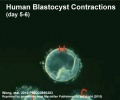
0 Response to "How Many Day 3 Embryos Make It To Blastocyst"
Post a Comment